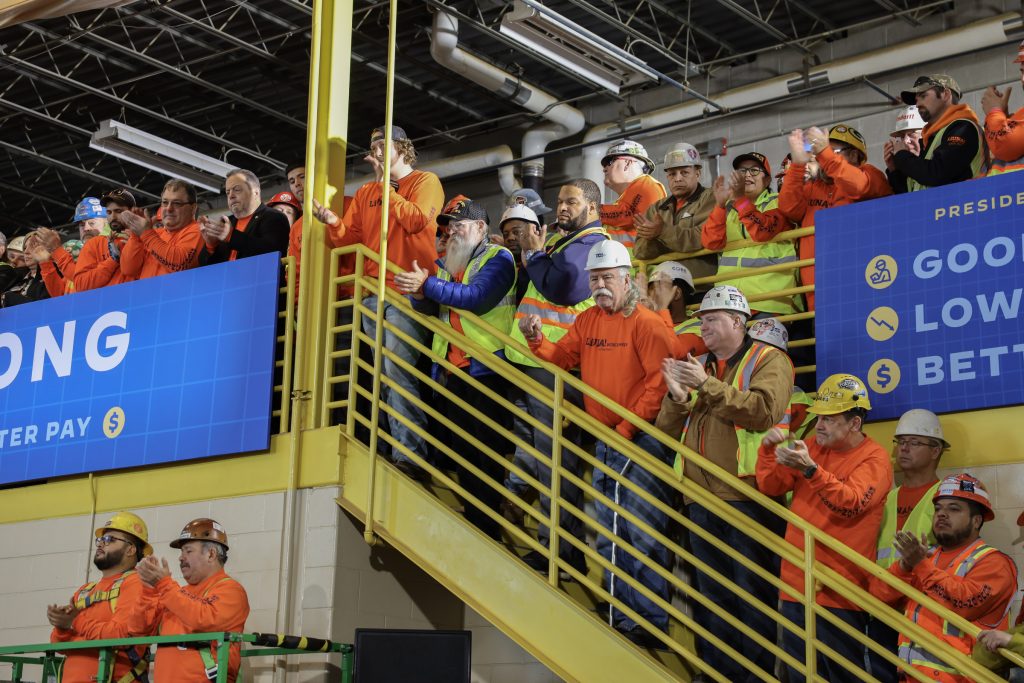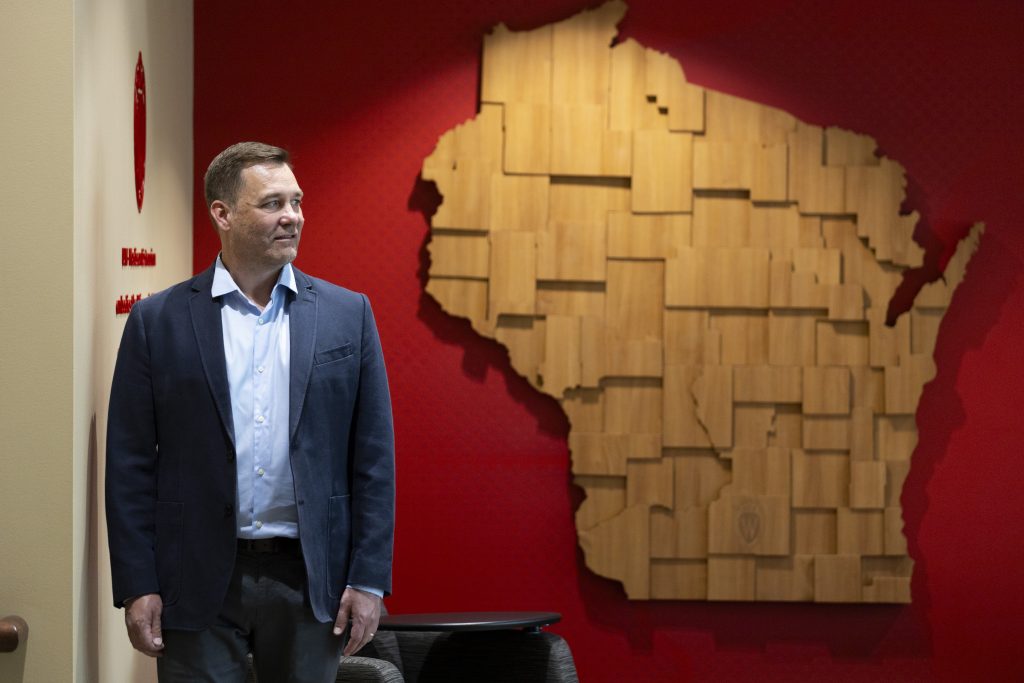Wisconsin Faces Looming Challenges With Aging Workforce
But impacts will be different by industry, given automation and different workforce ages.

Members of the Laborers’ International Union of North America (LIUNA) clap for President Joe Biden during his speech at the LIUNA training center in DeForest, Wis., on Feb. 8, 2023. (Drake White-Bergey / Wisconsin Watch)
This story was produced and originally published by Wisconsin Watch, a nonprofit, nonpartisan newsroom. It was made possible by donors like you.
Wisconsin Watch is starting a new beat called pathways to success, exploring what Wisconsin residents will need in order to build and keep thriving careers in the future economy — and what’s standing in their way.
The following interview has been edited for length and clarity.
What numbers do you think best tell the story of Wisconsin’s labor market and what’s coming?
Unemployment rates are still near historic lows, but despite that, we’re still not seeing a large number of people being hired. The hiring rate has slowed down. We’ve also seen fewer people being laid off. So more businesses are actually retaining employees that maybe they wouldn’t have otherwise. There’s still some hangover from the pandemic and ability to hire people, so they’re a little bit hesitant to let them go.
The number of job openings has ticked down as well. We’re still seeing some uncertainty from a lot of businesses in terms of what’s going to happen with inflation, interest rates, tariffs and just the broader U.S. economy.
Those numbers put together tell of a labor market that’s good for people who have a job right now, but maybe a little bit challenging for people looking for a job.
And how about when it comes to long-standing trends in Wisconsin’s labor market or demographics? Are there numbers you like to bring up that you think people don’t tend to know?
If you look at the working-age population declining from 2020 to 2030, and then kind of leveling off from 2030 to 2040, we’re just not going to have strong growth in the number of individuals who are working age in the state. That’s mostly true across the state, although there are some counties that will be projected to grow, like Dane and Eau Claire.
And then also, the combination of individuals of retirement age or nearing retirement age that are going to either leave the labor force or change the types of work they’re doing. If we look at the manufacturing sector, for instance, we have almost 131,000 individuals in that industry who are aged 55 or older, or almost 28% of that industry. So in those large employment sectors in the state, how do we think about replacing the workforce or augmenting the workforce going forward due to retirements or just shifting abilities due to the aging population?
How are the challenges or opportunities different in different parts of the state, say in urban areas versus more rural areas?
Certainly many of the non-metro areas do have an older population and will continue to have an older population going forward, so they will most likely face some of the bigger challenges in terms of some of the population shifts by age group. In some of those areas too, you have some of the bigger challenges in developing housing … to try and attract a new labor force. So those challenges are a bit twofold.

Matt Kures, community development specialist at the University of Wisconsin-Madison’s Division of Extension, is shown in his office building April 18, 2025, in Madison, Wis. (Joe Timmerman / Wisconsin Watch)
Would you describe Wisconsin as having a labor shortage?
The labor shortage is probably not as significant as it was, say, two or three years ago. But with our structural population distribution in terms of our age groups, we’re going to face challenges going forward. We’re going to have fewer individuals of working age.
What are your thoughts on how Wisconsin could fix that?
There’s a lot of strategies out there, and not one is going to be the sole key to solving labor problems going forward. Those strategies include thinking about ways to attract new individuals to our communities, creating quality places that people want to reside in, thinking about housing availability and affordability, and creating ecosystems where people can start a business.
So those are community-based strategies that people or communities can think about. But it’s also going to require improving productivity, and that could be through AI, automation, other capital investments and equipment, and thinking about new production techniques.
Can you tell me about some of the fastest-graying industries in Wisconsin, the ones where the most workers are aging out?
So we can look at this in two different ways: by numbers or percent. Some industries, on a percentage basis, have a very high share of individuals who are aging out of the workforce, but some of those are not the largest sectors in the state of Wisconsin.
But if you look at real estate, transportation, warehousing, wholesale trade, manufacturing and public administration, those are some of the biggest industries that have the highest share of individuals aged 55 or older, with manufacturing certainly being the largest in terms of total numbers with an estimated 131,000 employees aged 55 or older. That’s not surprising given that it’s a very large employment sector in the state.
You can also look at, say, health care and social assistance. They’re below the state average for their share of individuals aged 55 and older, but there’s almost 99,000 of them in that age category. So that’s an industry sector that, as we age as a state, will probably face even greater labor demands.
Of those graying industries, are there any that you’re particularly worried about?
I don’t know if “worried” is the term I would use because different industries will respond in different ways. For instance, manufacturing can probably rely a bit more on things like automation, while other industries might be able to have some of their jobs done remotely. But health care and manufacturing are two very large cornerstones of our economy, and they are going to face challenges with labor availability going forward.
When you say remotely, you mean they might use workers in other states?
Yes. But in an industry like health care, for the most part, that’s probably not going to be an option.
Can you tell me about a few of the fastest-growing industries in Wisconsin?
To be honest, I haven’t looked at any of the recent numbers on a sector-by-sector basis. I can say that health care and social assistance has been one of the largest growing sectors in the state, and that’s also true nationally.
Regardless of the industry, we’re seeing growth in demand for digital skills across all industry sectors. Especially in professional and technical services, we’re seeing a higher demand for digital skills, but across all industries, a lot of job postings require some sort of knowledge in terms of digital skills, which may be anything from software development all the way down to just being able to work with social media or operate word processing.
Anything else you want to talk about?
Thinking about the aging workforce, there are a lot of opportunities for businesses to make sure they capture and transfer a lot of the knowledge that those individuals may have gained over their careers. As new employees or younger employees come into those firms, are there opportunities to match up younger and pre-retirement workers to share all that knowledge and make sure that it benefits the organization going forward?
Have a question about jobs or job training in Wisconsin? Or want to tell a reporter about your struggle to find the right job or the right workers? Email reporter Natalie Yahr nyahr@wisconsinwatch.org or call or text 608-616-0752.
If you think stories like this are important, become a member of Urban Milwaukee and help support real, independent journalism. Plus you get some cool added benefits.





















